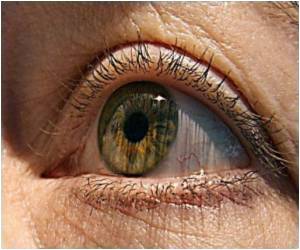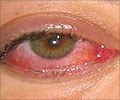The standard of practice for those treating Fuchs' Endothelial Corneal Dystrophy (FECD) could be changed based on the new findings published by a national consortium of researchers. Fuchs' Endothelial Corneal Dystrophy (FECD) is a disease characterized by cornea swelling that can eventually lead to the need for corneal transplantation. The Fuchs' Endothelial Corneal Dystrophy Genetics Multi-Center Study Group, led by co-principal investigators Jonathan Lass, MD, Charles I Thomas Professor and chair, Case Western Reserve University Department of Ophthalmology and Visual Sciences and director, University Hospitals Eye Institute, and Sudha Iyengar, PhD, professor, Departments of Epidemiology and Biostatistics, Genetics, and Ophthalmology, Case Western Reserve University School of Medicine, found that changes in the corneal thickness occur in patients at early stages of FECD even before swelling is observed in the clinical setting. Their study is published in the journal
Archives of Ophthalmology.
This new evidence suggests that FECD patients should have the thickness of their corneas measured annually to monitor progression of the disease. The disease affects the eye's endothelial cells or the back cell layer of the cornea, which maintains the cornea's normal thickness. However, as the disease advances, it was believed at its earlier stages the cornea remained clear and its thickness did not change. This study shows that the cornea in fact experiences a gradual swelling and becomes progressively thicker. Patients typically see an ophthalmologist only when the swelling becomes critical and the surface becomes swollen and the vision blurs. This study suggests ophthalmologists use ultrasonic technology to measure the potential progressive thickening of the cornea to assist in counseling patients on early surgical intervention before scarring develops and interferes with visual recovery.
"It's important if you have the disease, to be checked regularly and have your thickness measured. In the short term, if your vision is decreasing, an ophthalmologist can determine whether it is coming from your cornea or a concurrent cataract and that would assist a surgeon in intervening earlier with either cataract surgery, corneal transplantation, or continuing monitoring of the disease's progression," says Dr. Lass. "In the long term, it might be a way of determining drug intervention based on an individual's gene set, which may be causing the disease."
FECD is the most common reason for corneal transplantation in the United States. The disease usually becomes apparent on examination at its earlier stages in the 40s and 50s with visual impairment developing in the 60s and 70s. In addition, while the disease is more common in women than men and does have some familial heredity, it does occur sporadically. The study group is working to identify the genes that cause the disease.
"These findings have the potential to improve patient care for Fuchs corneal dystrophy, an often painful eye disease that can be difficult to manage," says Hemin Chin, PhD, National Eye Institute, program director for the study. "Clinicians now have an important tool to better monitor the disease and determine when surgical intervention is warranted, particularly for cataracts."
Source-Eurekalert











